
|
|
North AmericaStar lore of theNavajo |
|



The Navajo are one of the largest
Native American Nations in the United States, traditionally living in the
Four Corners area of the American west.
 Most of the star lore presented in this section is based on Nancy C. Maryboy's excellent work Navajo Skies.  Nancy C. Maryboy, Ph.D. of the Indigenous Education Institute writes: Navajo astronomy is little known, even among the Navajos. ... Navajo star knowledge is based on a world view and cosmology significantly different from western academic astronomy. Navajo astronomy can best be understood within a much larger context of Navajo philosophy.  Navajo Skies, which is quoted extensively on this site, is a comprehensive listing of Navajo constellations. The constellations are listed in order of their importance in Navajo Mythology.  Most of the Navajo constellations are identified by their modern astronomy equivalents. For some of them, however, only a vage location (like "northern sky") is given. |
Diné Universe
  © 2006 World Hope Foundation
© 2006 World Hope FoundationSource: grandcanyon.org |
 Nancy C. Maryboy explains that this was done "... in accordance with the desires of Navajo ceremonial practitioners and elders who wish the actual locations to remain anonymous in order to protect traditional knowledge." |



Nancy C. Maryboy explains:
There are eight main Navajo constellations, paired into twos, which are traditionally ordered in sequence. When one talks about these main
constellations, one traditionally follows this order, beginning with the North Star (Náhookòs Bikò‘) and ending with the Milky Way (Yikáísdáhá).
 According to Navajo tradition the three Náhookòs constellations are not considered to be separate but rather as one complete constellation. |



|
Náhookòs Bikò‘
The North Star, called Náhookòs Bikò‘, the Central Fire, depicts the central fire of a
hogan, a Navajo home.
|
 Náhookòs Bikò‘
© Melvin Bainbridge
Náhookòs Bikò‘
© Melvin Bainbridge
|



|
Náhookòs Bi’kà’
The stars of the Big Dipper, called Náhookòs Bi’kà’, the Male Revolving One,
can be culturally seen as a male warrior, a
leader who protects his people. He is sympathetic and charismatic, as well as a provider for his family and home.
|
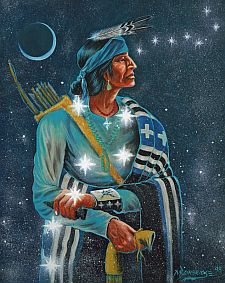 Náhookòs Bi’kà’
© Melvin Bainbridge
Náhookòs Bi’kà’
© Melvin Bainbridge
|



|
Náhookòs Bi’áád
In Navajo astronomy, the stars of Cassiopeia form the constellation
Náhookòs Bi’áád, the Female Revolving One.
This constellation is the female partner of Náhookòs Bi’kà’. She is a woman who exemplifies motherhood and regeneration. She provides growth,
stability in the home and the strength necessary for harmony.
|
 Náhookòs Bi’áád
© Melvin Bainbridge
Náhookòs Bi’áád
© Melvin Bainbridge
|



|
Dilyéhé
The Navajo call the Pleiades Dilyéhé, meaning "Pinlike Sparkles" or "Planting Stars."
|

|
 A number of other stories relate to the Pleiades as seven children or young men. 
|
One story tells of seven mischievous young boys who follow the ones who plant too late and snatch the seeds out of the ground. Another story refers
to a group of boys followed by a woman with a buckskin slung over her back. When the group goes over a hill, they are no longer seen in the night
sky. This is when the Pleiades disappear in early May.
 Yet Another story talks of the Béésh Ashiké, the Hard Flint Boys - young warriors who are also healers in one of the traditional cultural summer ceremonies. Other stories refer to the stars as a family: grandparents, parents, kids, and grandchil-dren, representative of the seeds of generations and regeneration. Incorporated in these stories are principles and values of traditional child rearing.
|
|   Béésh Ashiké
© Melvin Bainbridge
Béésh Ashiké
© Melvin Bainbridge
|
It is also said that when some of the Holy People were coming to this world by a rainbow, these were children that were too busy playing and got left
in the sky. These children represent youth.
 Sources: Navajo Skies, grandcanyon.org, Navajo Constellations Haashch’éshzhiní
In the Navajo creation story, Dilyéhé was the first constellation placed in the sky by Haashch’éshzhiní, Black God.
|
 Haashch’éshzhiní
© Melvin Bainbridge
Haashch’éshzhiní
© Melvin Bainbridge
|



|
Átsé Ets’óz
The Navajo add another facet to the world-wide picture of Orion as the big hunter. The costellation
is depicted as Átsé Ets’óz, First Slender One - a young man in the prime of life. He carries a bow and arrow and is a warrior protecting his
people. Like Dilyéhé, this constellation is related to planting and is seen every season except for part of the summer.
Legends of Orion and Scorpius representing antagonistic characters that can never be seen together in the sky are also part of Greek and Chinese mythology. |

|



|
Hastiin Sik’aí’ií
Hastiin Sik’aí’ií means "Man with a Firm Stance with Legs Ajar", or, more simple "Squatting Man."
|

|



|
Átsé Etsoh
The constellation Átsé Etsoh, First Big One, depicts an elderly man with a cane and a basket of seeds. He rep-resents the wisdom of the elders
and the concept of Sá'áh Naagháii Bik'éh Hózhóón, the concept that "with old age comes happiness or contentment." His a cane provides
strength and stability.
|

|



|
Gah Hahat’ee
The "Tail" of the Scorpion, consisting of λ, κ,
υ and ι1Scorpii
is called Gah Haat'e'ii, the "Rabbit Tracks."
|
 |



|
Yikáísdáhá
Yikáísdáhá, That Which Awaits the Dawn, is related to the annual Milky Way process. The emergence of pre-dawn is determined by the position of
the Milky Way that changes with the nights, months and seasons.
|
 Yikáísdáhá © Melvin Bainbridge
Yikáísdáhá © Melvin Bainbridge
|



|
The Chinle Unified School District near
Canyon de Chelly published a set of cards and posters, depicting the
main constellations of the Navajo. The images can be seen here. |
 Gah Hahat’ee
Gah Hahat’ee
|

 Náhookòs Bi’kà’
Náhookòs Bi’kà’
|
 Náhookòs Bikò‘s
Náhookòs Bikò‘s
|
 Náhookòs Bi’áád
Náhookòs Bi’áád |

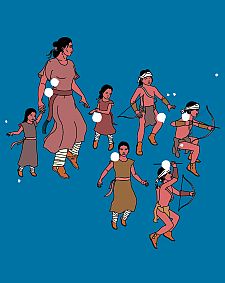 Dilyéhé
Dilyéhé
|
 Átsé Ets’ózí
Átsé Ets’ózí
|
 Hastiin Sik’aí’ií
Hastiin Sik’aí’ií
|
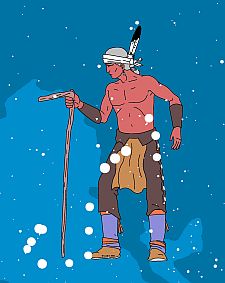 Átsé Etsoh
Átsé Etsoh
|



|
Ma’ii Bizò
Ma’ii or Coyote took part in the naming and placing of the star constellations during the Creation. He placed one star directly south, naming it
after himself, Ma’ii Bizò‘, the Coyote Star. This star is Canopus, which from Navajo land
appears to be directly south on the horizon.
The trickster, Ma’ii, or Coyote, is often credited with creating chaos, thus creating a larger order in the universe. One story goes this
way:
|

|



|
Dahsani
Dahsani the Porcupine is located in the northeastern part of the sky (no specific location s given).
|

|



|
Sò‘ Ahóts’i’
The constellation Sò‘ Ahóts’i’, Pinching or Doubtful Stars is located in the Hyades star cluster.
It is associated with Dilyéhé and Átsé Ets’ózí. The name Sò‘ Ahóts’i’ refers to doubtful or pinching stars. Pinching may allude to the
closeness of the twin stars, while doubtful may refer to their parentage.
|



|
Naayéé’ Neizghání dóó Tóbájíshchíní
The Hyades star cluster includes two stars that depict the Hero Twins, who slay the
monsters and make earth safe for humans. There are many stories of their exploits, which are well known to most Navajos.
|
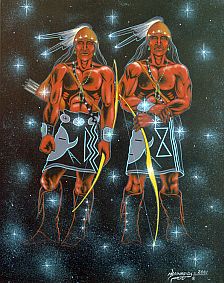 Naayéé’ Neizghání & Tóbájíshchíní
Naayéé’ Neizghání & Tóbájíshchíní© Melvin Bainbridge |



|
Shash
Shash, the Bear constellation is considered a spring and summer constellation. It consists of the stars of the Greek constellation
Sagittarius.
|

|



|
Ii’ni
Ii’ni, the Thunder constellation is similar to the Bear constellation. It is considered a spring and summer constellation and will first
appear with the heliacal rise in the pre-dawn hours of early spring. This occurs about the same time that the First Thunder of spring sounds on earth
signifying the coming of spring.
|
 Ii’ni
© Melvin Bainbridge
Ii’ni
© Melvin Bainbridge
|
 The essence of the Thunder constellation is depicted as a feather containing six stars. Each star represents a month and can be identified with the morning heliacal rise of the first bright star in the East, following the new crescent moon, for each of the six months. Unlike most Navajo constellations, the Thunder constellation covers a major portion of the sky and appears over many months. The first indication of its feather comes in the early morning hours in September/October (Denebola in Leo) and is completed in February/March (tip of Pegasus). The body takes an additional three months to completely appear, March, April and May, and remains visible during the rest of the summer.  Source: Navajo Skies |



|
Tsetah Dibé
Tsetah Dibé, the Mountain Sheep constellation is considered a winter constellation, primarily because of its association with the Navajo
winter Nightway ceremony. The constellation is thus visible in the winter months to the naked eye when it is very cold outside and when the moon is
not too bright. The constellation will appear over the evening eastern sky in early winter and will be overhead at dawn.
|

|
 During this time the winter nine-night ceremonies are being conducted and the sparkling constellation overhead is an indicator of dawn coming, signaling the completion of the night ceremonies. |



|
Tãish Tsoh
Tãish Tsoh, the Big Snake constellation is located in the southern sky made of parts of the Greek constellations
Puppis and
Canis Major.
|
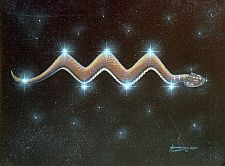 Tãish Tsoh
© Melvin Bainbridge
Tãish Tsoh
© Melvin Bainbridge
|



|
Tiníléí
Tiníléí, the Gila Monster constellation is situated in the northern sky, in
Andromeda, close to Cassiopeia.
|
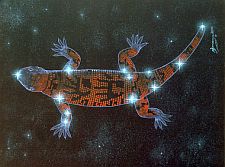 Tiníléí
© Melvin Bainbridge
Tiníléí
© Melvin Bainbridge
|



|
Kaalogi
Kaalogi, the Butterfly constellation is considered to be a southern constellation. It is adjacent to the First Big One, Átse’ Etsoh,
a part of the Greek constellation Scorpius.
|

|



|
Navajo Star Lore goes beyond constellations. There are deities associated with other events in the sky as well.
Haashch’ééh Yáãti’
Haashch’éé’ooghan
Jhil Gish
|
 Dawn in Monument Valley
Dawn in Monument ValleySource: maxpixel.net
|



|
Jo’hannaa’éí
Jo’hannaa’éí, the Sun and Tã’éhonaa’éí, the Moon are usually paired together. Together their cycles determine the times of the months
and the years.
|

|
The Sun is said to be a male energy, depicted by a perfectly round turquoise disc. It is said to be carried by a Sun Carrier as it makes its daily
rounds across the sky. It is often shown being carried by a humanlike person riding a horse.
 Source: Navajo Skies |



|
Tã’éhonaa’éí
Tã’éhonaa’éí, the moon is considered to be a female energy in relation to the male energy of the Sun. There are many stories about the moon,
often passed down through the female side of a family.
|

|


|
Back to Star Lore |
Back to Mythology |
 Back to North American Star Lore |
Back to Space Page |
Back to English |
 Back to Start Page |